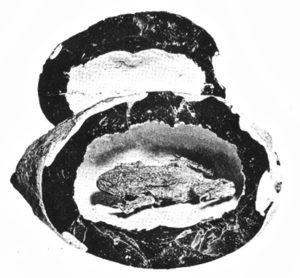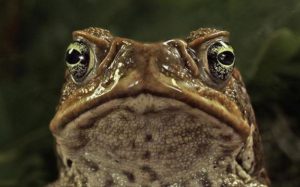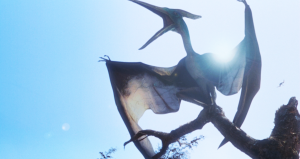
An alleged petrified toad found inside a stone
There’s some pretty weird stuff in this world, and much of it was chronicled by my personal hero Charles H. Fort. His work spawned an entire field of study, though there are those who balk at the suggestion that Forteana is anything but pure pseudoscience. I disagree, clearly.
Forteana covers a wide range of phenomena; from teleportation, to weird rain, to strange lights in the sky. In fact, all of the phenomena covered under the terms occult, supernatural, and paranormal can be considered Fortean. There’s a lot to read.
One such phenomena – one I don’t think Fort himself ever investigated, but I could be wrong – is Entombed Animals.
No, that’s not some elaborate funeral rite for dearly departed pets, it’s the strange occurrence of animals – usually frogs, but sometimes small lizards and other animals – being found encased inside rock (and other material). Strange indeed, but it gets stranger.
Of the 200-some reported cases of entombed animals, the vast majority found the animal alive…fully encased inside a void within the rock, or whatever material was involved. This, obviously, raises a few pertinent questions. Chiefly, how’d they get in there, and how are they still alive?
As mentioned, there are more than 200 known cases of entombed animals throughout Europe, North America, Africa, Australia and New Zealand since the fifteenth century. Some more notable than others, for example:
- In 1761, physician to Henry III of France, Ambroise Pare, reportedly found in a large and hard stone, a “…huge toad, full of life and without any visible aperture by which it could get there.”
- Scientific American published an article in 1864 describing the experience of a silver miner named Moses Gaines, who found a toad living inside a large boulder.[1] It was said that the toad had strange eyes that were much larger than those of other toads of the same species.
- 68 live toads were found inside a tree trunk in South Africa in 1876: “They were of a light brown, almost yellow color, and perfectly healthy, hopping about and away as if nothing had happened. All about them was solid yellow wood, with nothing to indicate how they could have got there, how long they had been there, or how they could have lived without food, drink, or air.”
Surprisingly, some relatively famous names have been connected with the toad-in-a-hole phenomenon, as it’s sometimes called (not to be confused with the English sausage casserole dish). Benjamin Franklin most notably, who wrote An Account of Toads Found Enclosed in Solid Stone[2], as well as Charles Dickens and Julian Huxley.

Toad is not impressed by your enthusiasm for this idea
Predictably, modern science claims that the entire idea is nonsense, and it’s hard to disagree, but for the number and quality of the reports. The journal Nature concluded, in 1910, that the explanation was quite simply “a frog or toad is hopping about while a stone is being broken, and the non-scientific observer immediately rushes to the conclusion that he has seen the creature dropping out of the stone itself.” That is, admittedly, a little flimsy.
Renowned paleontologist William Buckland – the man who first described and named the Megalosaurus – conducted experiments in the 1820’s, wherein he placed toads into carved chambers in limestone and sandstone blocks and buried them in his garden. A year later he dug them up and, not surprisingly, most of the toads were dead and decaying. But not all of them; an undisclosed number of the toads encased in limestone survived for a full 12 months, cemented inside stone and buried underground. Buckland then reburied the surviving toads and found, another 12 months later, that all had perished.[3]
That’s a fairly incredible result, and there are many theoretical explanations for why those toads survived under those conditions. Such as micro-pores in the limestone allowing small amounts of oxygen and water into the void, and various forms of suspended animation (which some frog species are known to employ during hibernation).
This of course says nothing about how the toads and other animals in the 200 plus accounts of toad-in-a-hole got into the rocks, trees or wherever they were found. This defies logic like a teenager defying his parents. Are we talking some kind of teleportation? Macro-osmosis? Magic?
It’s conceivable that fertilised toad eggs could have gotten trapped in sediment and eventually ended up embedded inside certain kinds of stone, such as limestone. But limestone forms over millennia or at the very least many centuries; wouldn’t that mean that the toad, or its egg, was live or viable inside the stone for hundreds or thousands of years? And what about other kinds of animals?
 You can see why the scientific establishment just shakes its proverbial head and walks away amid a cloud of frustrated exhaustion in the face of our tomfoolery. These reports exist though, and are of the sort that aren’t easy to dismiss, so we’re in a bit of a quandary.
You can see why the scientific establishment just shakes its proverbial head and walks away amid a cloud of frustrated exhaustion in the face of our tomfoolery. These reports exist though, and are of the sort that aren’t easy to dismiss, so we’re in a bit of a quandary.
There hasn’t been a recorded occurrence of an entombed animal since about 1980, so DNA analysis and other modern scientific methods have never been applied to this phenomenon, outside of an examination of the anecdotal accounts. Thus, many questions about specific species, age, and special genetic conditions are left unanswered.
And speaking of anecdotal accounts, I leave you with the following incredible but unconfirmed (and highly suspect) report coming to us from the Illustrated London News of 1856:
“Workmen were digging a railway tunnel through a layer of Jurassic limestone when they were startled to find a large creature stumbling out of a recently split boulder, flapping what looked like wings, and croaking. It died immediately. The creature was identified as a pterodactyl by a local paleontology student who recognized the characteristic features of the extinct reptile. The stone in which it was found was consistent with the time period in which pterodactyls lived and formed an exact mold of the creature’s body.”[4][5]
[1] Age of the Human Race: Scientific American 11, 228-228 (8 October 1864) doi:10.1038/scientificamerican10081864-228a
[2] Benjamin Franklin. “An Account of Toads Found Enclosed in Solid Stone.” In The Works of Benjamin Franklin, ed. Jared Sparks. Volume VI. 1882. 441–442.
[3] Curiosities of Natural History. Blackwood’s Edinburgh Magazine – March 1858 pg.360
[4] Johnathan Whitcomb. Tunnel Pterodactyl of 1856. Live Pterosaurs: http://livepterosaurs.blogspot.ca/2010/04/tunnel-pterodactyl-of-1856.html
[5] Living Fossils – Weird Encyclopedia: http://www.weird-encyclopedia.com/living-fossils.php
